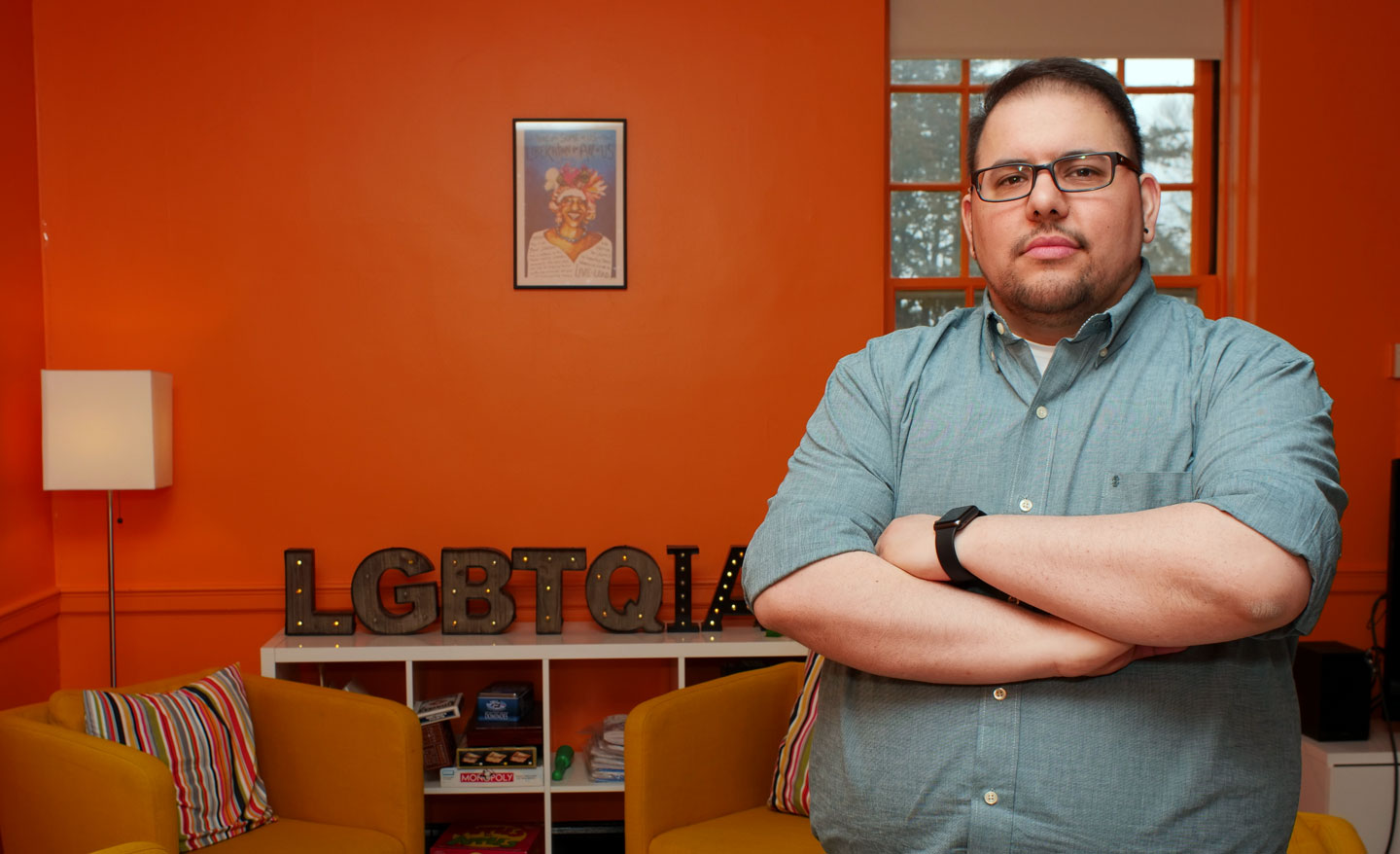Ten Years of LGBTQIA
Erin Duran helps design a vision for the LGBTQIA Center’s future.
Erin Duran sits in an armchair inside the LGBTQIA Center’s warm, orange-hued interior. He has just finished booking Julio Salgado, one of many impressive guests to visit Conn this spring.
Salgado is an undocumented, self-described queer artist of color who uses bold colors, racy imagery and impactful language in his works. Duran points to a Salgado painting hanging to his left.
Duran goes on to name other icons whose images and words he would like to display prominently in the center: Marsha P. Johnson. Jennicet Gutiérrez. Audre Lorde.
“I made the choice in conversation with students to get some artwork by and including queer people of color on the walls, because that wasn’t here before,” says Duran, who uses the simpler and shorter “queer” to reference the LGBTQIA community. “I had Julio’s artwork up before I knew that I could bring him, just because I think it’s really important and timely artwork to display.”
Duran arrived at Conn in the fall to serve as the center’s first full-time director, 10 years after student leaders successfully established a dedicated space to meet the needs of lesbian, gay, transgender, queer and questioning students. In a nod to the growing and diverse needs of this community of students, intersex and asexual were added to the center’s name this year.
Through the years, Conn has earned a reputation as one of the friendliest colleges in the nation for LGBTQIA students, according to HuffPost and Campus Pride. Besides providing a supportive space, the center includes a resource library and hosts regular social events and educational programming.
Duran is looking to build on that reputation as he helps design a vision for the center’s future, and sees the conversation continuing to evolve as he coordinates events and programming that will reach beyond Burdick House, where the center is located.
He is trying to encourage discussions about what he describes as queer identities that accurately reflect the diversity and depth within the community. That’s why the spring programming at Conn has included Yazmin Watkins, the bisexual spoken-word artist who attended the Black Women’s Conference. Hayden Kristal, a deaf transgender activist, was invited to teach signs for queer terminology. And Etai Pinkas, an Israeli LGBTQIA activist, visited Conn to shed light on Israel’s gay, lesbian, bisexual and transgender community.
“Students come in here wanting to make sure that the work we’re doing and the conversations we’re having are reflective of the richness and diversity of the queer community and of the queer experience,” Duran says. “I’m really trying to push these conversations forward in ways that recognize the wholeness of human beings, and the fact that we’re never just queer. All our identities are intersecting and informing the way we live our lives.”
Providing a space for students to engage in conversations about their identity has never been more necessary, or more complex. Duran hears questions such as how to come out to your best friend and how to engage a professor who continues addressing you by the wrong pronoun.
“It’s about offering a place where the community can come together to celebrate their identities and find relationships with one another,” he says. “And to have the chance to meet people who identify similarly to students and talk about some of the nuances of what it means to be queer on a college campus.”
Yet Duran wants to move conversation beyond that. And his celebration of queer icons is part of it.
“I want queer-identified students to know that they are part of a broader queer community. And as we move outside of this room, I want them to know that our queer community is part of a broader Conn community. Just as we value one another within the LGBTQIA community, we value each other in the broader community as well.”
As the center is poised to enter its next 10 years, Duran sees the work of centers like the LGBTQIA continuing to serve a critical need. When federal guidelines regarding protections for transgender students were rolled back this spring, Duran started planning. Working with his colleagues in Conn’s Division of Institutional Equity and Inclusion, Duran had a lunchtime informational meeting for students scheduled for the next day.
“As policies are changing and as the climate might be making our students feel unsafe, unsupported or concerned, the centers can play a key role in leading those conversations,” Duran says.
At the same time, collaboration between student resource centers is growing, and educational outreach to the broader Conn community is just as important.
“We’re looking for opportunities to help folks realize that this is not just a space for queer people. Unity House is not just a place for people of color, and the Womxn’s [previously called Women’s] Center isn’t just a place for folks who identify as women. These are resources for the entire campus community. Everyone is welcome.”
